Cooking measurements, cooking equivalents, and cooking conversions can be really confusing at times, but they don’t have to be! I’m explaining all the basics when it comes to measuring and converting in the kitchen, including how to convert metric to standard, common cooking measurements and equivalents, and more. Plus we’ve got a FREE printable Kitchen Measurement Conversion Chart for you, so you can check it any time you need!
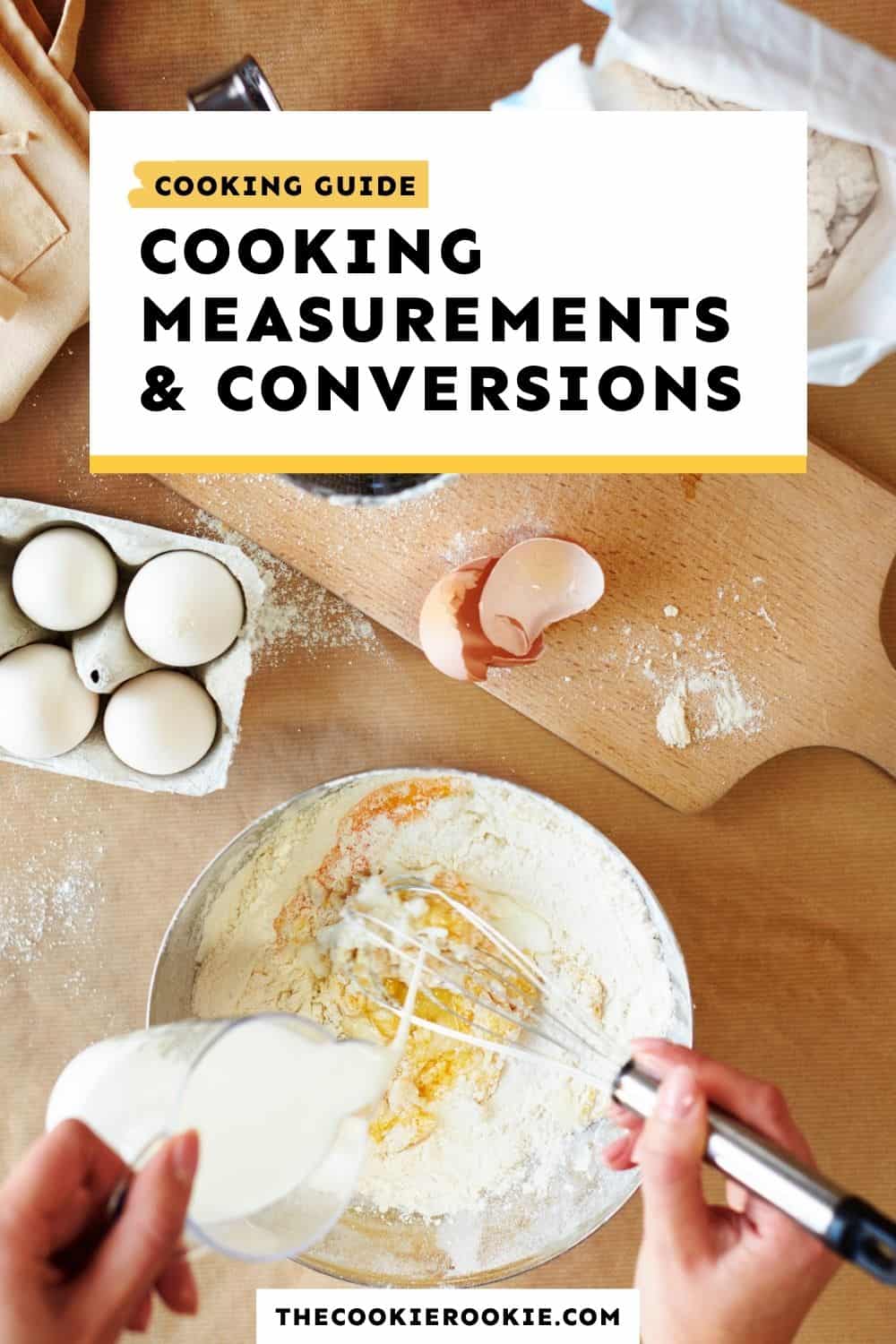
This post may include affiliate links that earn us a small commission from your purchases at no extra cost to you.
Cooking Measurements & Cooking Conversions
Cooking measurements and cooking conversions are a point of confusion for many people. Whether you’re a beginner at cooking or a seasoned home chef, sometimes measurements just don’t seem to make sense!
You’ve got tablespoons and cups, and then there’s fluid ounces. And on top of that, there’s recipes that use metric cooking measurements but you only understand U.S. standard measurements…it’s a lot. Cooking measurements and equivalents should be one of the first steps in learning how to cook, but it’s easy to get by still not quite understanding it all.
I’m going to explain everything you need to know about basic cooking measurements, converting metric to imperial/standard in the kitchen, understanding kitchen measurement equivalents, AND give you a free printable kitchen conversion chart to help you figure it all out. Cooking should be fun and easy, not some kind of math test.
So if cooking conversions and measurements cause you pain on a regular basis, this post is for you! I’m here to help so that you can follow recipes without hassle and feel CONFIDENT in the kitchen.
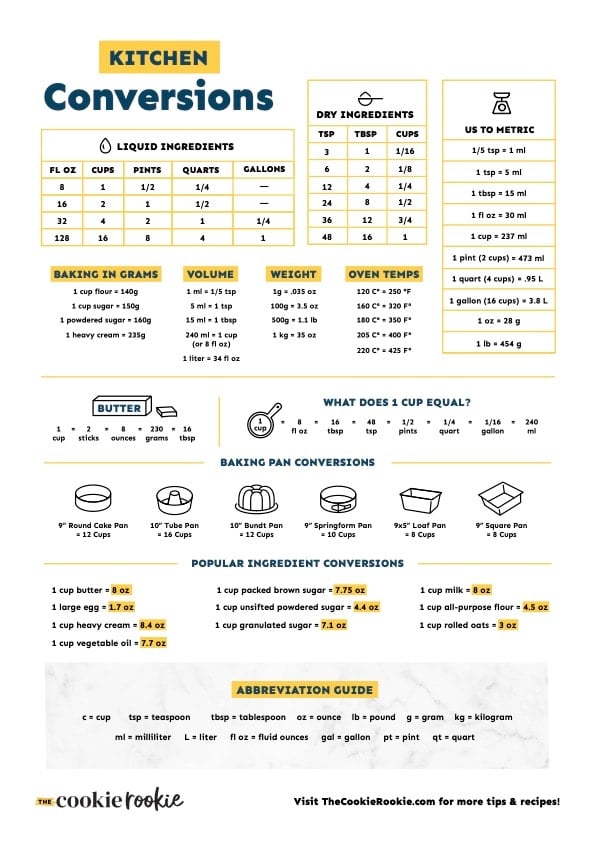
Be sure to bookmark this post and/or grab our free printable kitchen measurement conversion chart so you always have the information handy!
Kitchen Measurement Tools
Most of your cooking measurements can be done with these basic kitchen measurement tools.
Remember that liquid ingredients and dry ingredients should always be measured with the proper tools (i.e. measure liquids in a liquid measuring cup, measure dry ingredients in dry measuring cups).
A kitchen scale can be used when ingredients need to be weighed instead of measured by cups, etc. This is ideal for more exact recipes, or when using recipes that measure by weight (in grams, for example).
- Measuring spoons
- Measuring cups
- Liquid measuring cup
- Kitchen scale
Cooking Measurements Abbreviations
When you’re following a recipe, it’s pretty important to understand those cooking abbreviations. Many recipes (including mine) will use shorthand when writing out recipes, and if you don’t know what they mean, you could end up making a few mistakes.
Kitchen Measurement Abbreviations (Standard and Metric)
| Abbreviation | Measurement |
|---|---|
| tbsp | tablespoon |
| tsp | teaspoon |
| oz | ounce |
| fl. oz | fluid ounce |
| c | cup |
| qt | quart |
| pt | pint |
| gal | gallon |
| lb | pound |
| mL | milliliter |
| g | grams |
| kg | kilogram |
| l | liter |
Measuring Liquid Ingredients vs. Dry Ingredients
Dry ingredients and liquid ingredients should be treated differently when measuring. Measuring cups and spoon sets are generally intended for dry ingredients, while liquid measuring cups are (obviously) intended for liquid ingredients. Using the right measuring tools will ensure exact measurements.
- When measuring dry ingredients, generally you should fill the cup to the brim, and then scrape the excess off the top to get the most accurate amount (scoop and level method). This cannot be done with a liquid measuring cup, which is just one reason why it should not be used.
- While you will get more exact liquid measurements with the liquid measuring cup, when a recipe calls for small amounts of liquid, sometimes you will need to use measuring spoons instead.
- These tips are most important when making recipes that truly require exact measurements (like baking recipes).
Ounces vs Fluid Ounces
Using ounces vs fluid ounces comes back to the liquid ingredients vs dry ingredients. Ounces measure weight, while fluid ounces measures volume. Dry ingredients can be measured in ounces (by weight), while liquid ingredients are measured in fluid ounces (by volume). So if a recipe calls for 8 ounces of flour, that doesn’t mean you need 1 cup.
Rest assured, most U.S. recipes (using standard/imperial system) will list dry ingredients by cups/tablespoons/etc rather than by ounces. Just keep this in mind when measuring your ingredients!
Basic Kitchen Conversions & Equivalents
Understanding basic cooking measurements and cooking conversions is important knowledge to have in the kitchen. When you’re following a recipe, you need to know what it all means. And sometimes you just can’t find that darn tablespoon to measure out your ingredients, so you have to wing it. But if you know that 1 tablespoon also equals 3 teaspoons, then you can measure away without worry!
Just follow these kitchen conversion charts, and soon enough you’ll memorize them just like those multiplication charts from school. Check our How to Cut Recipes in Half post if you need help with that too.
Dry Measurements Conversion Chart
| Teaspoons | Tablespoons | Cups |
|---|---|---|
| 3 tsp | 1 tbsp | 1/16 c |
| 6 tsp | 2 tbsp | 1/8 c |
| 12 tsp | 4 tbsp | 1/4 c |
| 24 tsp | 8 tbsp | 1/2 c |
| 36 tsp | 12 tbsp | 3/4 c |
| 48 tsp | 16 tbsp | 1 c |
Liquid Measurements Conversion Chart
| Fluid Ounces | Cups | Pints | Quarts | Gallons |
|---|---|---|---|---|
| 8 fl. oz | 1 c | 1/2 pt | 1/4 qt | 1/16 gal |
| 16 fl. oz | 2 c | 1 pt | 1/2 qt | 1/8 gal |
| 32 fl. oz | 4 c | 2 pt | 1 qt | 1/4 gal |
| 64 fl. oz | 8 c | 4 pt | 2 qt | 1/2 gal |
| 128 fl. oz | 16 c | 8 pt | 4 qt | 1 gal |
Butter Measurements Chart
| Sticks | Cups | Tablespoons | Ounces | Grams |
|---|---|---|---|---|
| 1/2 stick | 1/4 c | 4 tbsp | 2 oz | 57.5 g |
| 1 stick | 1/2 c | 8 tbsp | 4 oz | 115 g |
| 2 sticks | 1 c | 16 tbsp | 8 oz | 230 g |
Metric Cooking Measurement vs Standard/Imperial Cooking Measurements
Here in the U.S., we use the Imperial, or “Standard”, measurement system. So our recipes are measured in teaspoons, tablespoons, cups, pounds, etc. We’re in a bit of a bubble on that though, because the rest of the world (for the most part) uses the metric system. Recipes are generally measured in grams and milliliters.
So what happens when you want to use a recipe that uses metric cooking measurements, but you only know (and only have tools for) imperial cooking measurements? Well that’s where cooking conversions charts come in handy!
Whether you’re trying to measure for volume or weight, or need to convert oven temperatures from Celsius to Fahrenheit (or vice versa), these charts will help you get it right.
Metric to US Cooking Conversions
Use these charts to quickly convert metric measurements to standard/imperial measurements (including oven temperatures!).
Oven Temperatures Conversion
| (Degrees) Celsius | (Degrees) Fahrenheit |
|---|---|
| 120° C | 250° F |
| 160° C | 320° F |
| 180° C | 350° F |
| 205° C | 400° F |
| 220° C | 425° F |
Liquid Measurements (Volume)
| Metric | Standard |
|---|---|
| 1 mL | 1/5 tsp |
| 5 mL | 1 tsp |
| 15 mL | 1 tbsp |
| 240 mL | 1 c (8 fl. oz) |
| 1 liter | 34 fl. oz |
Dry Measurements (Weight)
| Metric | Standard |
|---|---|
| 1 g | .035 oz |
| 100 g | 3.5 oz |
| 500 g | 17.7 oz (1.1 lb) |
| 1 kg | 35 oz |
US to Metric Cooking Conversions
| Standard | Metric |
|---|---|
| 1/5 tsp | 1 ml |
| 1 tsp | 5 ml |
| 1 tbsp | 15 ml |
| 1 fl. oz | 30 ml |
| 1 c | 237 ml |
| 1 pt | 473 ml |
| 1 qt | .95 l |
| 1 gal | 3.8 l |
| 1 oz | 28 g |
| 1 lb | 454 g |
What Does 1 Cup Equal?
I think it’s helpful to know what 1 cup equals, because even when you’re short on kitchen measuring tools, most people will have a 1 cup measurement. If you have that, you can go far! Plus it can be useful for making cooking conversions when trying to halve or scale recipes. Just remember that 1 cup equals these various measurements….which means that everything in this chart is equivalent!
- 1 cup = 8 fluid ounces
- 1 cup = 16 tablespoons
- 1 cup = 48 teaspoons
- 1 cup = ½ pint
- 1 cup = ¼ quart
- 1 cup = 1/16 gallon
- 1 cup = 240 ml
Note: Keep in mind the difference between dry and liquid ingredients. In the U.S., recipes often use “cups” for both liquid and dry ingredients. But it is implied that 1 cup of a liquid will be measured with a liquid measuring cup, while 1 cup of a dry ingredients will be measured with a dry measuring cup.
Baking Pan Conversions
Sometimes you come across an awesome cake recipe that’s made for a specific type of baking pan…but you don’t have that type or size, or you just prefer to make a different style of cake. No worries! By figuring out how much cake batter goes into each cake pan, you can change up the recipe to fit in another type of baking pan. The cups refer to how much batter fits into the pan.
- 9-inch round cake pan = 12 cups
- 10-inch tube pan =16 cups
- 10-inch bundt pan = 12 cups
- 9-inch springform pan = 10 cups
- 9 x 5 inch loaf pan = 8 cups
- 9-inch square pan = 8 cups
Common Baking Measurements (Conversions)
Remember earlier when I told you about the difference between ounces and fluid ounces? Here are some numbers to back up the importance of that tip. 8 fluid ounces of liquid will often equal 1 cup, but 8 ounces (weight) of a dry ingredient will rarely equal 1 cup.
Baking in Ounces
| Measurement/Ingredient | Ounces |
|---|---|
| 1 c. all-purpose flour | 4.5 oz |
| 1 c. granulated sugar | 7.1 oz |
| 1 c. unsifted powdered sugar | 4.4 oz |
| 1 c. packed brown sugar | 7.75 oz |
| 1 c. rolled oats | 3 oz |
| 1 c. vegetable oil | 7.7 oz |
| 1 c. milk | 8 oz. |
| 1 c. heavy cream | 8.4 oz |
| 1 c. butter | 8 oz. |
| 1 large egg (white + yolk) | 1.7 oz |
Baking in Grams
| Measurement/Ingredient | Grams |
|---|---|
| 1 c. all-purpose flour | 127 g |
| 1 c. granulated sugar | 200 g |
| 1 c. unsifted powdered sugar | 125 g |
| 1 c. packed brown sugar | 220 g |
| 1 c. rolled oats | 85 g |
| 1 c. vegetable oil | 218 g |
| 1 c. milk | 227 g |
| 1 c. heavy cream | 238 g |
| 1 c. butter | 227 g |
| 1 large egg (white + yolk) | 48 g |
I hope these basic cooking measurements and cooking conversions help clear things up a bit! I know cooking and baking measurements have caused me a lot of confusion in the past, and I want cooking and following recipes to be EASY. I want it to make sense so that you guys can enjoy cooking and feel confident in the kitchen.
Printable Kitchen Measurements Conversions Chart

Click for FREE Printable of this Kitchen Conversions Chart
Cooking Resources
Find more basic cooking info, resources, charts, and more to help you out in the kitchen.
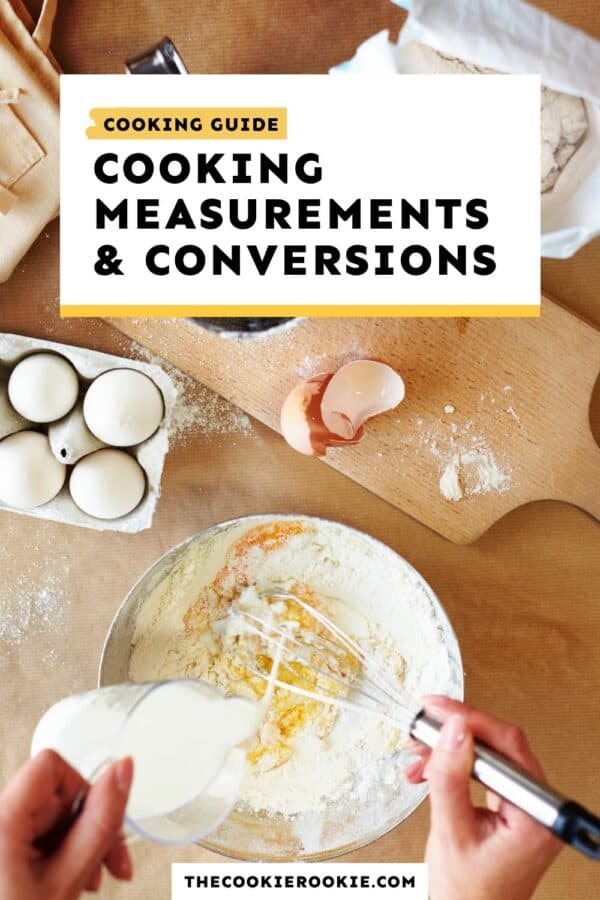
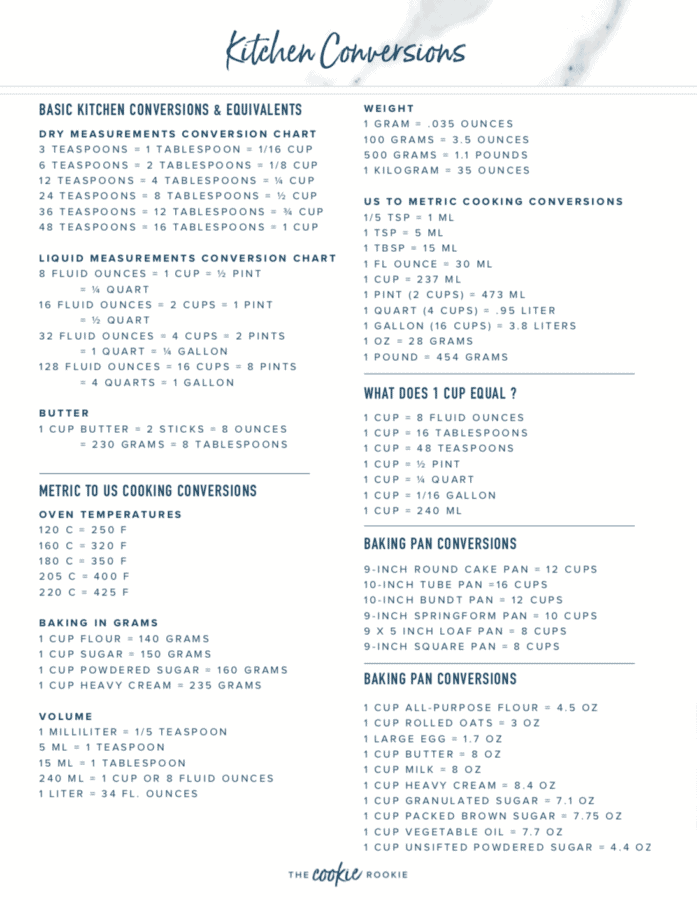
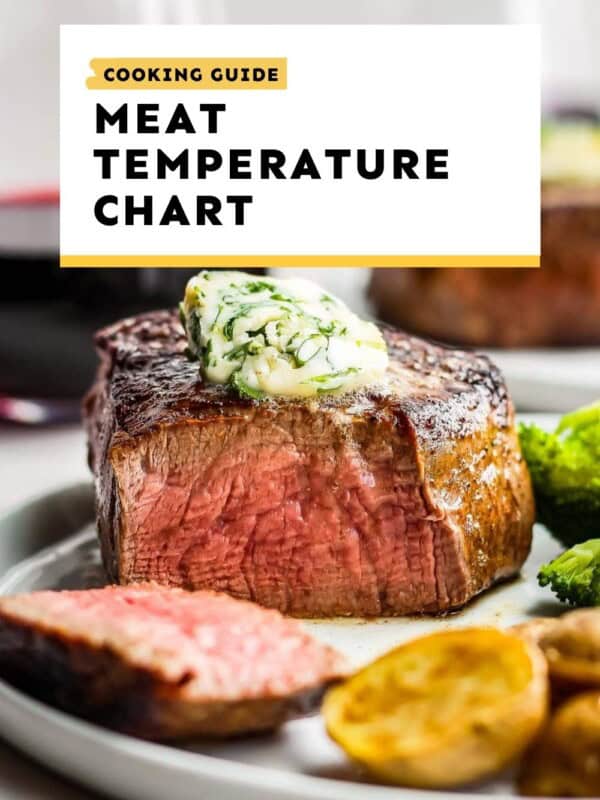
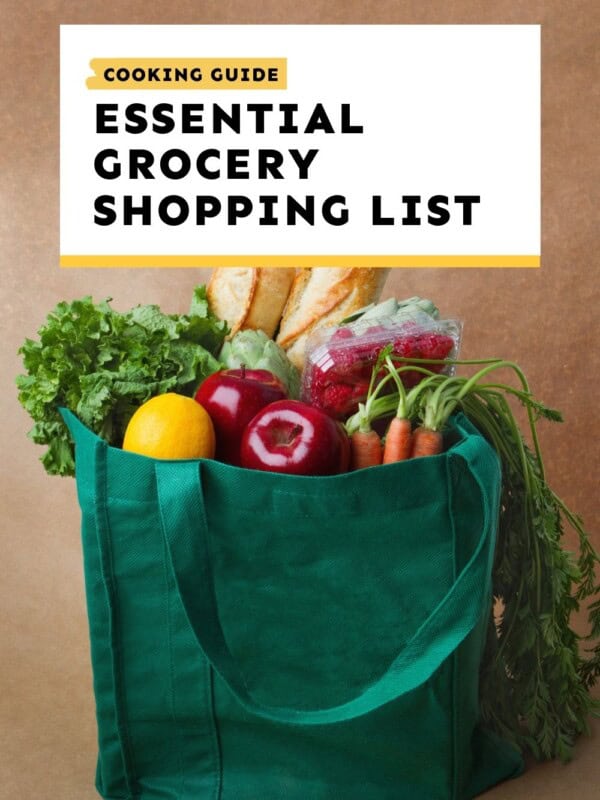
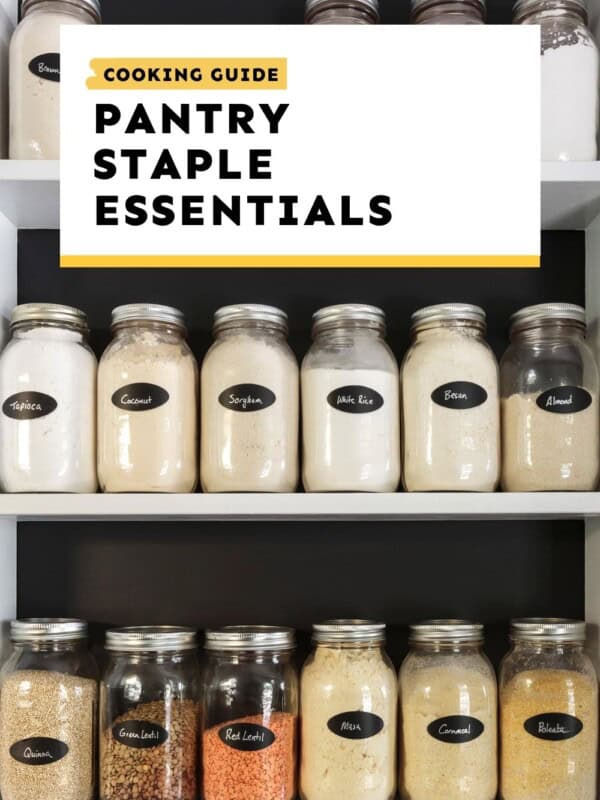
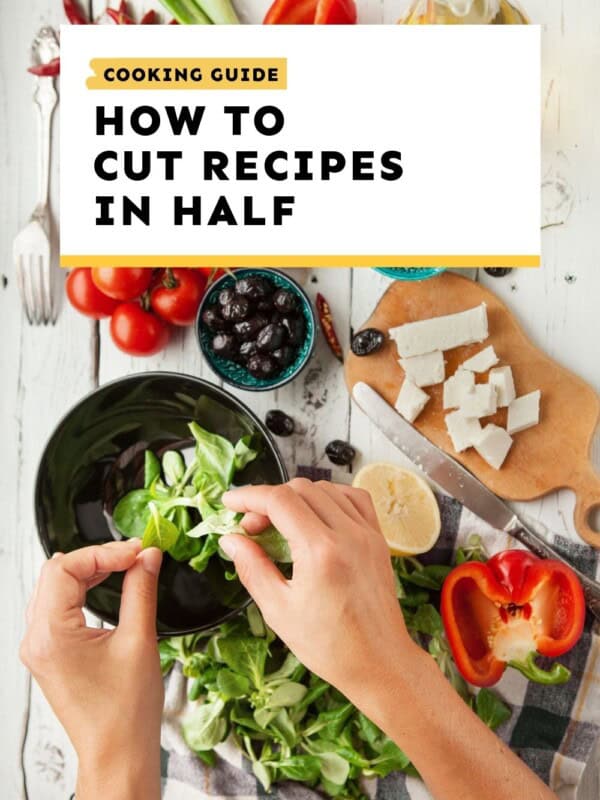
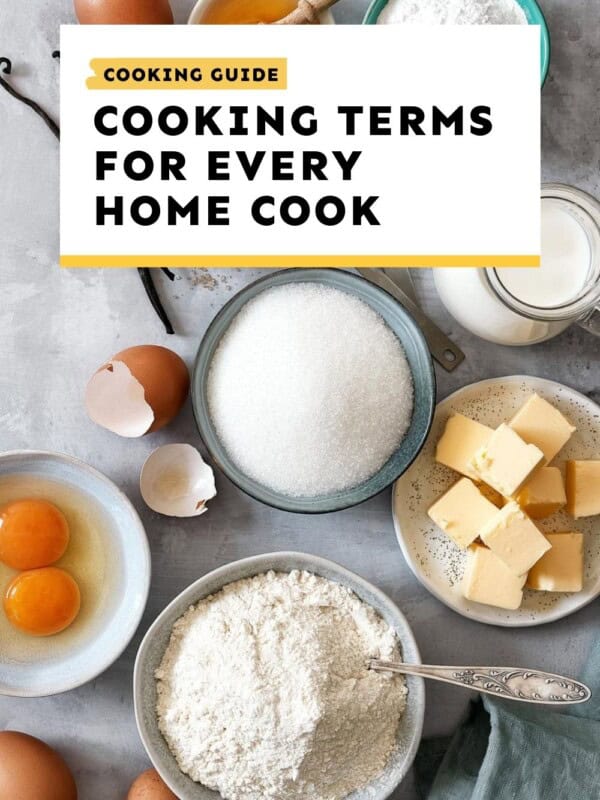
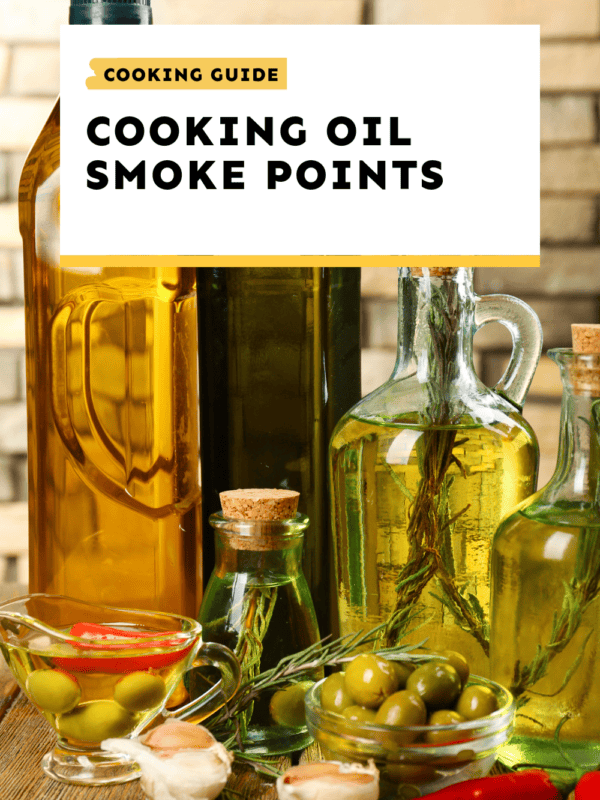
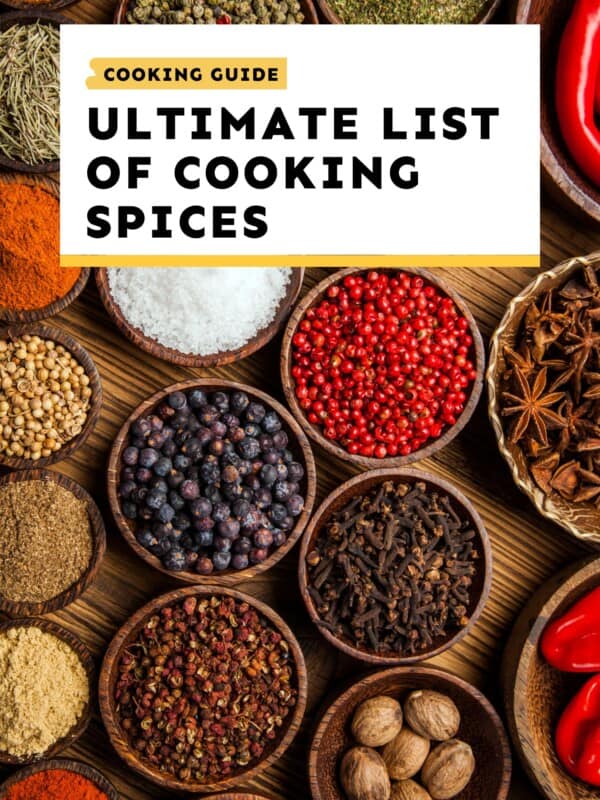
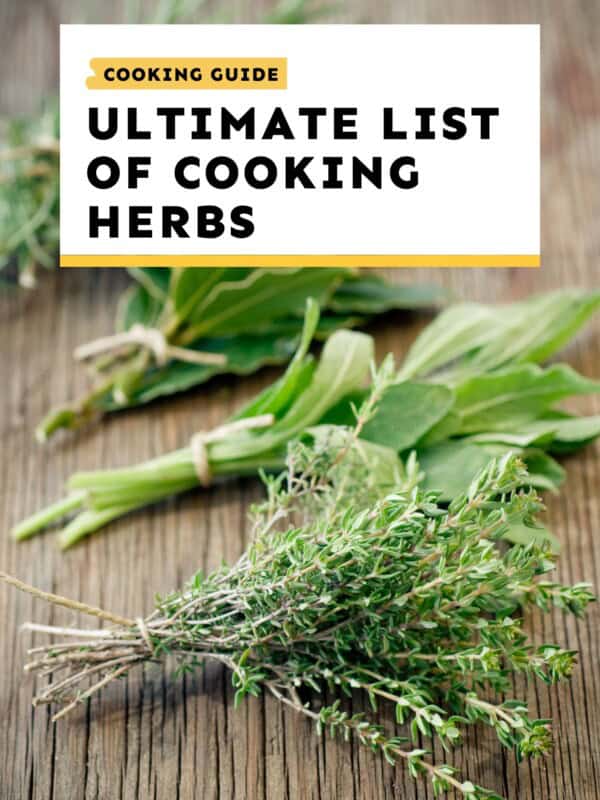






This is a great resource! Thank you for putting it together.
We’re so glad you enjoyed this post, Jennifer! Thanks for stopping by!
Thank you SO MUCH Becky, I’m grateful to have found your website. Your recipes are mouthwatering & amazing, yet realistic to achieve. You also provide great tips & helpful hints, it makes me feel as though I actually can create them myself. The way you’ve laid out your site is truly helpful but not overwhelming (except for the pop up ads). Thank you for all that you do!!
Thanks so much for your kind words, Angela!
I have a question not sure if I will word it right or not but here it goes. What are the measures of cooking teaspoon and tablespoon or ounces and pounds or quarts or quorts
If I’m understanding, you’re asking what a teaspoon of something weighs. The answer is that it varies depending on the ingredient. A teaspoon, tablespoon, fluid oz, pint, etc is a unit of volume- that is how much of an ingredient fits into a specific amount of space. A tsp or cup of heavy cream will weigh more than a tsp or cup of water, for example. Both the heavy cream and water are taking up the same amount of space (volume- tsp or oz). In this example, 1 cup of heavy cream weighs 8.4 oz (240 g) while the cup of water weighs 8.0 oz (224 g).
All of that boils down to the weight of a tsp, cup, pint, etc will change depending on what you are weighing. There are many websites with charts that give the weights of various amounts of common ingredients. They can be found easily via Google. Good luck!
All of the weights for ingredients are wrong! It shows in this chart that powered sugar weights more for a cup than sugar and flower (which all of those weights are wrong too); BE CAREFUL USING THIS CHART, and recheck things.
I don’t know what chart you’re looking at, but the charts above are correct. Powdered (not powered) sugar weighs less per cup than granulated because the volume in the cup contains more air. The same goes for flour (not flower).
You are a life saver. Thank you for your conversion chart! Now I just need to find conversions from kilograms to grams to use my kitchen scale.
Thanks for stopping by!
K=1000, so 1Kg is equal to 1000 grams
These conversions helped a lot since i am not very good at math i always have to guestimate. now i printed them.
Thanks
Happy to have helped!
The world talks metric only the USA not. Why not give measurements in metric instead of the lay cook needing to work with a calculator in the hand
I am based in the United States and most of my following is from the US as well!
When are you creating your page as you described? This person didn’t charge you for their effort. Say thank you, and go create what you need.
can you tell me how to convert 450 grams of butter &
450 grams of sour cream?
THANK YOU
454 grams is a pound so 450 would be a little less than a pound!
How much is a 1/3 cup to ounces
2 and 2/3 ounces!
your equivalent for butter is inaccurate. 1 cup = 16 Tbsp, not 8 Tbsp.
Some great information here, but the butter equivalent is incorrect.
Butter measurement equivalents
US Cups Grams Ounces Tablespoons
1/8 cup of Butter 28.4 g 1 oz 2 Tbsp
1/4 cup of Butter 56.7 g 2 oz 4 Tbsp
1/3 cup of Butter 75.6 g 2.7 oz Approx 5 Tbsp
3/8 cup of Butter 85 g 3 oz 6 Tbsp
½ cup of Butter 113.4 g 4 oz 8 Tbsp
5/8 cup of Butter 141.8 g 5 oz 10 Tbsp
2/3 cup of Butter 151.2 g 5.3 oz 11 Tbsp
¾ cup of Butter 170.1 g 6 oz 12 Tbsp
7/8 cup of Butter 198.5 g 7 oz 14 Tbsp
1 cup of Butter 226.8 g 8 oz 16 Tbsp